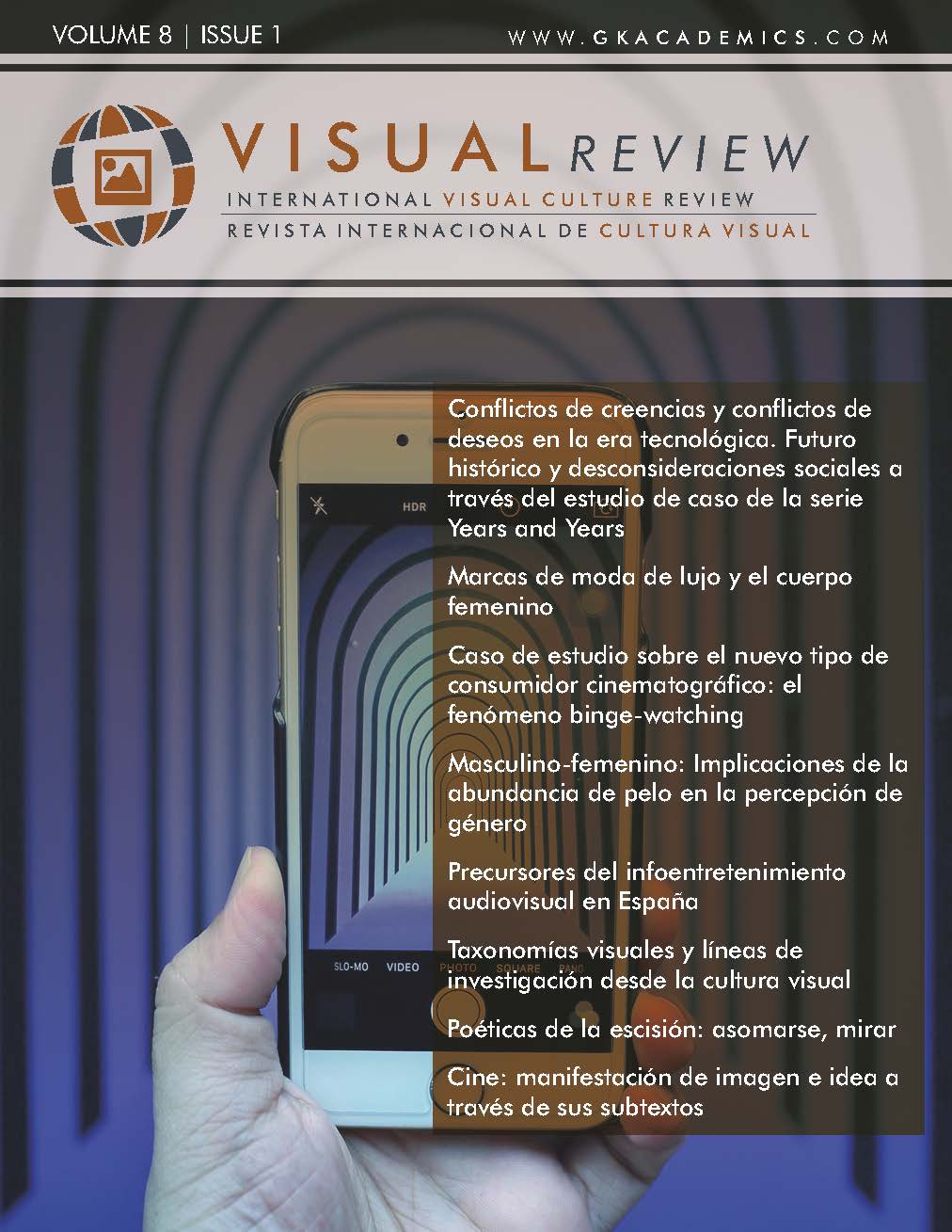Luxury fashion brands and the female body
Absence of Corporate Social Responsibility in Instagram advertising
DOI:
https://doi.org/10.37467/gka-revvisual.v8.2866Keywords:
luxury fashion brands, female body, women, advertising, corporate social responsibilityAbstract
This work focuses on analyzing whether luxury fashion brands, considered to Forbes magazine 2018, contribute with social responsibility for the sake of female inclusion. For this, we have been taken as a sample the profiles of the most influential Instagrammers of size XL at the international level in 2019, published by the magazine Trendencias (2019). Applying a qualitative-descriptive methodology, it has been shown that luxury fashion brands that are advertised on Instagram induce the consolidation of a social system in which perfect bodies prevail, according to the traditional canon of beauty
Downloads
Global Statistics ℹ️
|
1389
Views
|
696
Downloads
|
|
2085
Total
|
|
References
Álvarez Fernández, J.T. (2013). Manejo de la comunicación organizacional. Madrid: Díaz de Santos. Recuperado de: https://www.editdiazdesantos.com/wwwdat/pdf/9788499694474.pdf
Batey, M. (2013). El significado de la marca. Buenos Aires: Ed. Granica.
Blanes, M.J. (2017). Las curvy como modelo de celebritización y empoderamiento en Instagram. CIC, Cuadernos de Información y Comunicación, 22, 203-221. https://doi.org/10.5209/CIYC.55975 DOI: https://doi.org/10.5209/CIYC.55975
Crane, A., McWilliams, A., Matten, D., Moon, J., & Siegel, D.S. (2008). The corporate social responsibility agenda. In: A. Crane, A. McWilliams, D. Matten, J. Moon & D.S. Siegel (Eds), The Oxford Handbook of Corporate Social Responsibility (3-15), Oxford University Press. DOI: https://doi.org/10.1093/oxfordhb/9780199211593.001.0001
Díaz Soloaga, P. (2007). Valores y estereotipos femeninos creados en la publicidad gráfica de las marcas de moda de lujo en España. Anàlisis, 35, 27-45. Recuperado de: https://ddd.uab.cat/pub/analisi/02112175n35/02112175n35p27.pdf
Díaz Soloaga, P., Quintas Froufe, N. y Muñiz, C. (2012). Cuerpos mediáticos vs. Cuerpos reales. Un estudio de la representación del cuerpo femenino en la publicidad de marcas de moda en España. Icono 14, Revista de comunicación y tecnologías emergentes, 8(3), 244-256. https://doi.org/10.7195/ri14.v8i3.237 DOI: https://doi.org/10.7195/ri14.v8i3.237
Fombrun, C. & Van Ries, C.B.M. (2004). Fame and Fortune: how successful companies build winning reputation. Upper Sadle River: Financial Times/Prentice Hall/Pearson.
González-Aldrete, O. A. (2017). Las marcas de lujo: su percepción y la decisión de compra. Trabajo de Obtención de Grado, Maestrías en Mercadotecnia Global. Tlaquepaque, Jalisco: ITESO. Recuperado de: https://rei.iteso.mx/bitstream/handle/11117/5387/Las+marcas+de+lujo+su+percepci%F3n+y+la+decisi%F3n+de+compra.pdf?sequence=2
Manovich, L. y Tifentale, A. (2016). Competitive Photography and the Presentation of the Self. Exploring the Selfie: Historical, Analytical and Theoretical Approaches to Digital Self-Photography. Palgrave Macmillan, forthcoming. Recuperado de: http://manovich.net/index.php/projects/competitive-photography-and-the-presentation-of-the-self
Núñez, Domínguez, T. (2019). El papel de las mujeres en la publicidad. Madrid: Santillana.
Lindner, K. (2004). Images of women in general interest and fashion magazine advertisements from 1955 to 2002. Sex Roles, 51(7/8), 409-421. https://doi.org/10.1023/B:SERS.0000049230.86869.4d DOI: https://doi.org/10.1023/B:SERS.0000049230.86869.4d
Peña Guardia, M. A. (2015). La eficacia de las modelos delgadas vs. las modelos normales en anuncios de lencería. ¿Quién vende más? Trabajo Final de Grado. Universitat Autònoma de Barcelona. Recuperado de https://ddd.uab.cat/pub/tfg/2015/138429/TFG-_Mariona_Pena.pdf
Ridgway, J.L. y Clayton, R.B. (2016). Instagram unfiltered: exploring associations of body image satisfaction, Instagram selfie posting and negative romantic relationship outcomes. Cyberpsychology, Behavior and Social Networking, 19(1), 2-7. https://doi.org/10.1089/cyber.2015.0433 DOI: https://doi.org/10.1089/cyber.2015.0433
Segarra Saavedra, J. e Hidalgo Martí, T. (2018). Influencers, moda femenina e Instagram: el poder de prescripción en la era 2.0. Revista Mediterránea de Comunicación, 9(1), 313-325. https://doi.org/10.14198/MEDCOM2018.9.1.17 DOI: https://doi.org/10.14198/MEDCOM2018.9.1.17
Soley-Beltrán, P. (2012). Muñecas que hablan. Ética y estética de los modelos de belleza en publicidad y moda. Revista de Dialectología y Tradiciones Populares, 67(1), 115-146. doi: 10.3989/rdtp.2012.05 DOI: https://doi.org/10.3989/rdtp.2012.05
Thomas, D. (2007). Deluxe. How luxury lost its luster. Nueva York: Penguin Book.
Viñarás Abad, M.; Cabezuelo Lorenzo, F. & Herranz de la Casa, J.M. (2015). Filosofía Corporativa y Valores de marca como ejes del nuevo paradigma comunicativo. Prisma Social. Revista de ciencias Sociales, 14, 379-410. Recuperado de: https://www.redalyc.org/pdf/3537/353744530012.pdf
Downloads
Published
How to Cite
Issue
Section
License
Those authors who publish in this journal accept the following terms:
-
Authors retain copyright.
-
Authors transfer to the journal the right of first publication. The journal also owns the publishing rights.
-
All published contents are governed by an Attribution-NoDerivatives 4.0 International License.
Access the informative version and legal text of the license. By virtue of this, third parties are allowed to use what is published as long as they mention the authorship of the work and the first publication in this journal. If you transform the material, you may not distribute the modified work. -
Authors may make other independent and additional contractual arrangements for non-exclusive distribution of the version of the article published in this journal (e.g., inclusion in an institutional repository or publication in a book) as long as they clearly indicate that the work was first published in this journal.
- Authors are allowed and recommended to publish their work on the Internet (for example on institutional and personal websites), following the publication of, and referencing the journal, as this could lead to constructive exchanges and a more extensive and quick circulation of published works (see The Effect of Open Access).













